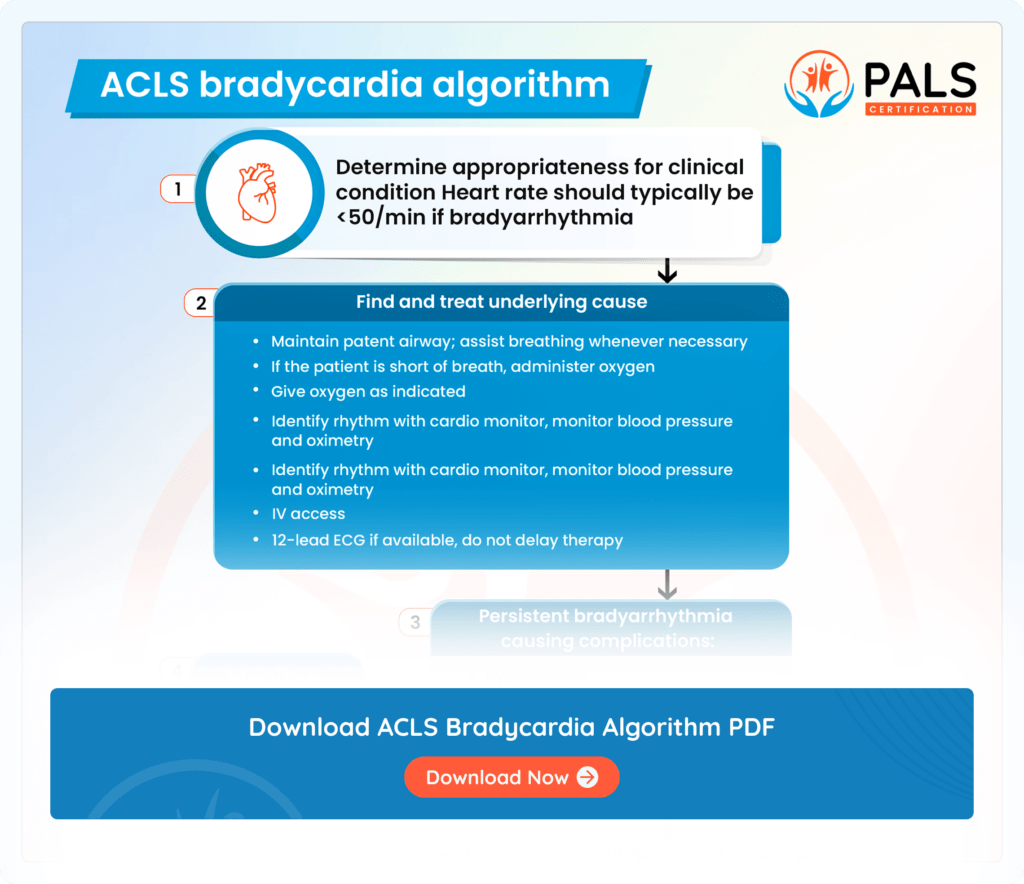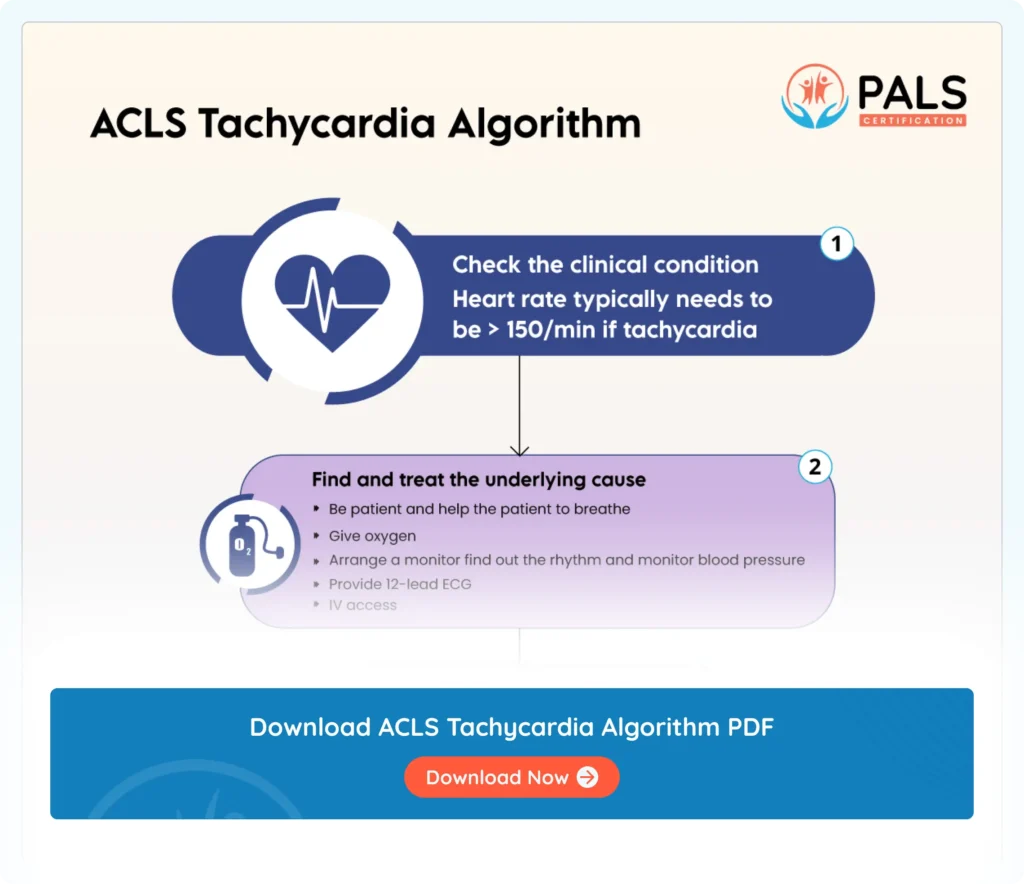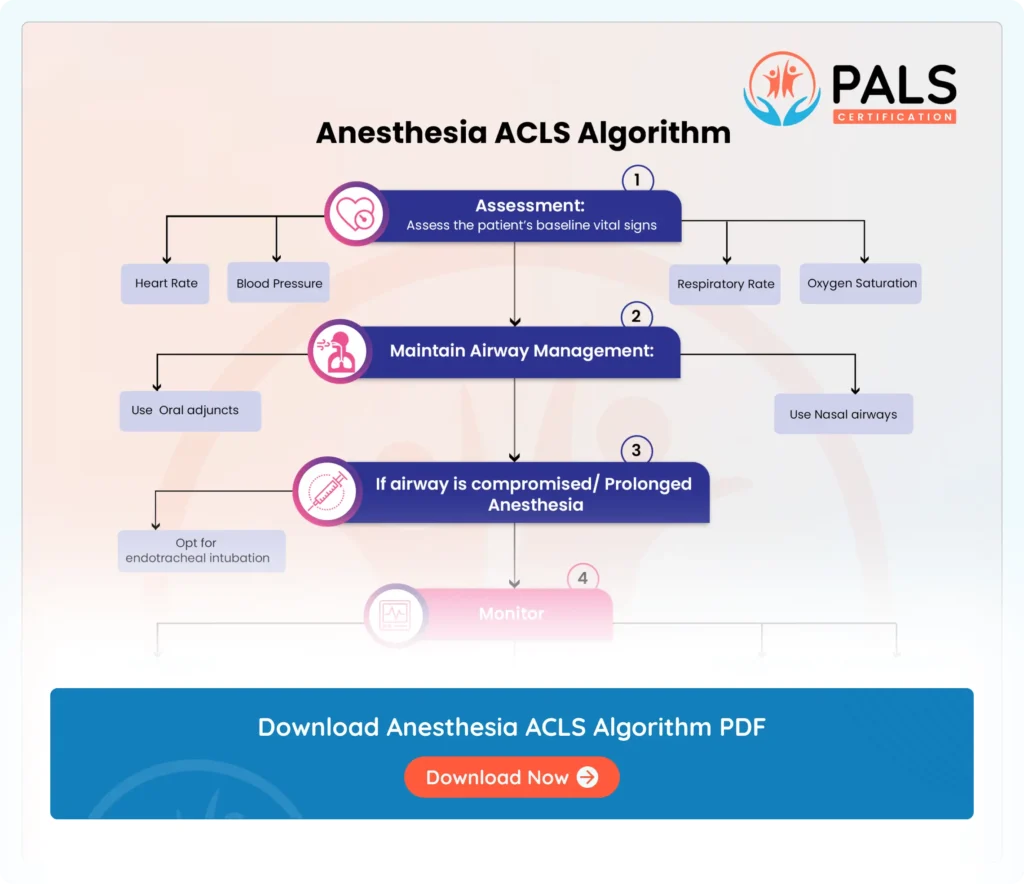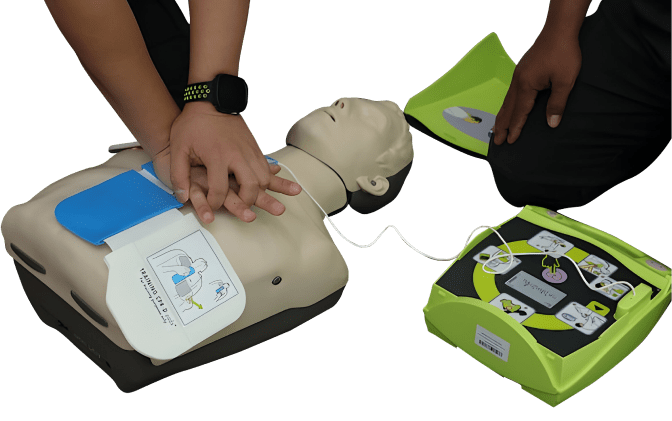- 4.0 CE Credit Hours
- For Pediatric Responders
- Includes Videos, Megacode Scenarios, Practice Tests & More
- FREE BLS Included
The ACLS (Advanced Cardiovascular Life Support) cardiac arrest algorithm provides a step by step guideline for medical professionals. This guideline enables seamless intervention that helps effectively manage life threatening situations like pediatric cardiac or respiratory arrest.
This algorithm outlines the series of critical steps chronologically, to maximize the chances of positive patient outcomes. Emergencies are unpredictable and therefore it creates a lot of confusion and chaos, delaying emergency interventions.

Online PALS certification and recertification
- Compliant with ECC and OSHA guidelines
- Nationally accepted course
- Available anytime, anywhere
- Earn CE credit hours
$119

Step by step analysis of flowchart
- Confirm Cardiac Arrest
- Understand via unresponsiveness, absence of normal breathing
- Check for Pulse
- Initiate CPR (Cardiopulmonary Resuscitation)
- Administer CPR
- Rate: 100-200 Compressions per minute.
- Ventilation 30:2 (If rescue breaths are provided)
- Monitor & use AED for shockable rhythms(ventricular fibrillation or pulseless ventricular tachycardia)(
- Deliver single shock with CPR
- After using AED
- Continue CPR for 2 minutes (5 cycles)
- Assess rhythm again after 2 mins of CPR
- If shockable rhythm still persists: Deliver another shock and resume CPR immediately.
- If rhythm is unshockable (asystole or pulseless electrical activity): Continue CPR
- Administer Epinephrine
- 1 mg IV/IO every 3-5 minutes
- Continue
- Alternate cycles of CPR
- Rhythm assessment
- Defibrillation (if needed)
- Using Amiodarone or Lidocaine
- Optimize oxygenation and ventilation
- Consider Endotracheal intubation or Supraglottic airway
- Treat reversible causes of Cardiac arrest
- Hypoxia, Hypovolemia, Hydrogen ion [acidosis], Hypo-/Hyperkalemia, Hypothermia, and T’s: Tension pneumothorax, Tamponade, Toxins, Thrombosis—coronary and pulmonary).
- Continue Post-resuscitation care
- Targeted temperature management
- Optimize hemodynamics
- Provide supportive care post-return of spontaneous circulation (ROSC)
Highlights of ACLS Cardiac Arrest Algorithm
- Recognition of Cardiac Arrest: Prompt identification of cardiac arrest through assessment of unresponsiveness, absence of normal breathing, and lack of pulse in the child.
- Activation of Emergency Response: Initiating the emergency response system and assigning roles to team members for efficient coordination.
- High-Quality CPR: Immediate initiation of high-quality chest compressions at a rate of 100 to 120 compressions per minute, ensuring adequate depth and allowing for full chest recoil between compressions. Coordinated ventilation with chest compressions at a ratio of 30:2 if providing rescue breaths.
- Defibrillation: Rapid attachment of a monitor/defibrillator to assess and deliver a shock if indicated for shockable rhythms such as ventricular fibrillation or pulseless ventricular tachycardia.
- Medication Administration: Administration of medications such as epinephrine to support circulation and optimize outcomes. Other medications like amiodarone or lidocaine may be administered per ACLS guidelines based on the patient’s rhythm and condition.
- Systematic Rhythm Assessment: Regular assessment of the patient’s cardiac rhythm to determine the need for defibrillation and to guide further interventions.
- Management of Reversible Causes: Identification and treatment of underlying reversible causes of cardiac arrest, such as hypoxia, hypovolemia, electrolyte imbalances, toxins, tension pneumothorax, tamponade, and thrombosis.
- Advanced Airway Management: Consideration and implementation of advanced airway management techniques, including endotracheal intubation or supraglottic airway placement, to optimize oxygenation and ventilation if indicated.
- Post-Resuscitation Care: Initiation of targeted temperature management (if indicated), optimization of hemodynamics, and provision of supportive care following return of spontaneous circulation (ROSC).
- Transport: Arrangement for immediate transfer to an appropriate care facility for further evaluation and management post-ROSC.
Available Courses
PALS Certification and Recertification
ACLS Certification and Recertification
- 6.0 CE Credit Hours
- For Healthcare Professionals
- Includes Videos, Megacode Scenarios, Practice Tests & More
- FREE BLS Included
$119.00 $169.00
Get CertificateBLS Certification and Recertification
- 6.0 CE Credit Hours
- For Medical Fields
- Includes CPR & First Aid Bag-Mask Techniques
$36.95 $39.90
Get CertificateSources
- Algorithms https://cpr.heart.org/en/resuscitation-science/cpr-and-ecc-guidelines/algorithms
- Emergency Medical Services Response to Cardiac Arrest https://www.ncbi.nlm.nih.gov/books/NBK321505/
- Immediate Post-Cardiac Arrest Care Algorithm https://acls.com/articles/post-cardiac-arrest/
- BLS, ACLS, & PALS Algorithms https://www.aclsmedicaltraining.com/acls-algorithms/
- Management of Cardiac Arrest https://www.ahajournals.org/doi/10.1161/CIRCULATIONAHA.105.166557
- Cardiopulmonary Resuscitation (CPR) https://emedicine.medscape.com/article/1344081-overview?form=fpf
- Resuscitation https://academic.oup.com/book/31761/chapter-abstract/265757398?redirectedFrom=fulltext
- Advanced Life Support Algorithm https://lms.resus.org.uk/modules/m25-v2-als-algorithm/11118/resources/chapter_6.pdf
- Shockable vs. Non Shockable Heart Rhythms https://avive.life/blog/shockable-vs-non-shockable-heart-rhythms/
All ACLS Algorithms

ACLS Bradycardia Algorithm
An ACLS Bradycardia algorithm helps you learn the guiding interventions for emergency slow heart rates

ACLS Tachycardia algorithms
ACLS tachycardia algorithm helps manage elevated heart rates through systematic interventions for optimal patient outcomes

Anesthesia ACLS Algorithm
Know how to assess vital signs, secure airway and initiate CPR when needed. Administer ACLS drugs, address reversible causes and adapt management to patient’s condition for anesthesia emergencies.


